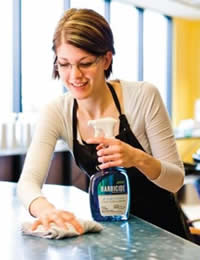Difference between Disinfection and Sterilization
Key Difference: Disinfection refers to the process that kills most of the disease producing microorganisms. On the other hand, sterilization refers to the process that is used to render a product free from any viable microorganisms.
 Disinfection and sterilization are both processes that are used to eliminate the microorganisms that can cause diseases. However, disinfection should only be used in a scenario where
Disinfection and sterilization are both processes that are used to eliminate the microorganisms that can cause diseases. However, disinfection should only be used in a scenario where  sterilization is not possible as sterilization guarantees removal of pathogens. Surface of fragile items like impressions are generally disinfected rather than sterilized.
sterilization is not possible as sterilization guarantees removal of pathogens. Surface of fragile items like impressions are generally disinfected rather than sterilized.
Disinfection is the process that destroys the microorganisms, especially the ones that cause disease. However, it eliminates only a defined scope of microorganisms. The process of Disinfection is also used for the inhibition of microorganisms's growth. However, inhibiting the growth of microbes is less absolute. An item is known to be a sterile when it is completely free from the measurable levels of microorganisms. Sterilization is generally achieved by maintaining a high-pressure environment and/or high temperatures over a very long time.
Some of the differences are listed below:-
|
|
Disinfection |
Sterilization |
|
Definition |
It refers to the process that deactivates the disease producing microorganisms. |
It is a process that destroys all microbial life including highly resistant bacterial endospores. |
|
Applied to medical devices |
ECG machines Oximeters Bedpans, urinals |
Surgical instruments Biopsy instruments Foot care equipment Cytoscopes |
|
Disinfectants/ Sterilants |
Heat Disinfectant: Moist heat
Liquid Disinfectants: Glutaraldehyde, hydrogen peroxide, chlorine dioxide, chlorine compounds, paracetic acid
Intermediate level disinfectants include phenolic and iodophor compounds and low level disinfectants include quaternary ammonium compounds. |
Physical Sterilants: Steam under pressure, dry heat filteration, Ultraviolet radiation, ionizing radiation
Gas Vapor Sterilants: Ethylene oxide, formadehyde vapor, hydrogen peroxide vapor, plasma gas, chlorine dioxide gas
Chemical Sterliants: Peracetic acid, Glutaraldehyde
|
|
Bacterial spores |
Cannot be removed. |
Can be removed or killed. |
|
Methods |
May use physical or chemical methods. |
Combination of heat, chemicals, irradiation, high pressure and filtration. |
|
Level of cleanliness |
Adequate |
Extreme |
|
Processing Time |
Depends upon the process: For example, heat sensitive semi critical patient care items can be pasteurized for about 50 minutes. |
Depends upon the process: For example, heat tolerant critical instruments can be sterilized by steaming (about 40 minutes) and dry heat (about 1 to 6 hrs); depending upon the temperatures. |
| New Methods |
Ortho-phthalaldehyde (Cidex OPA) Antimicrobial coating (Surfacine) Superoxidized water (Sterilox) |
Liquid sterilization process (Endoclens) Rapid readout ethylene oxide biological indicator (Attest) |
| Methods |
Physical methods Boiling and pasteurization Ultraviolet radiation Chemical agents Alcohols Aldehydes Halogens Phenols Surfactants Heavy metals Dyes Oxidants |
Physical methods Moist heat in autoclaves Dry-heat in ovens Gamma irradiation Filtration Plasma sterilization Chemical agents Ethylene oxide Glutaraldehye (high concentration) |
Image Courtesy: nailsmag.com, aspjj.com









Comments
i like it
malik zahid rasool
Tue, 02/04/2014 - 17:08
Add new comment